
Forage is a plant material eaten by grazing livestock. Historically, the term forage has meant only plants eaten by the animals directly as pasture, crop residue, or immature cereal crops, but it is also used more loosely to include similar plants cut for fodder and carried to the animals, especially as hay or silage.

Lolium is a genus of tufted grasses in the bluegrass subfamily (Pooideae). It is often called ryegrass, but this term is sometimes used to refer to grasses in other genera.

Lolium persicum is a species of flowering plant in the family Poaceae. It is referred to by the common names Persian darnel or Persian ryegrass, and is an annual grass. It has an upright stem, branching from a reddish base, up to 45 cm tall. Its leaves are lower surface glossy, dark green, 6 mm wide.

Festuca (fescue) is a genus of flowering plants belonging to the grass family Poaceae. They are evergreen or herbaceous perennial tufted grasses with a height range of 10–200 cm (4–79 in) and a cosmopolitan distribution, occurring on every continent except Antarctica. The genus is closely related to ryegrass (Lolium), and recent evidence from phylogenetic studies using DNA sequencing of plant mitochondrial DNA shows that the genus lacks monophyly. As a result, plant taxonomists have moved several species, including the forage grasses tall fescue and meadow fescue, from the genus Festuca into the genus Lolium, or alternatively into the segregate genus Schedonorus.
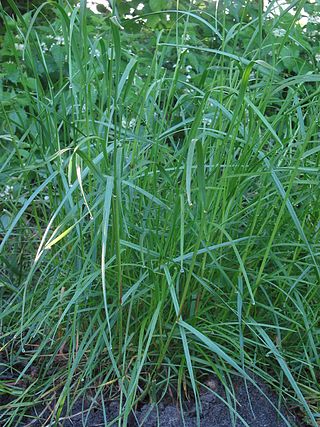
Lolium perenne, common name perennial ryegrass, English ryegrass, winter ryegrass, or ray grass, is a grass from the family Poaceae. It is native to Europe, Asia and northern Africa, but is widely cultivated and naturalised around the world.

Lolium pratense, meadow fescue is a perennial species of grass, which is often used as an ornamental in gardens, and is also an important forage crop. It grows in meadows, roadsides, old pastures, and riversides on moist, rich soils, especially on loamy and heavy soils.

Tragus, commonly called bur gras, burr grass or carrot-seed grass, is a genus of plants in the grass family. It is native to Africa, Australia, and Eurasia with several species on islands in the Atlantic, Indian, and Pacific Oceans plus one species in Argentina.
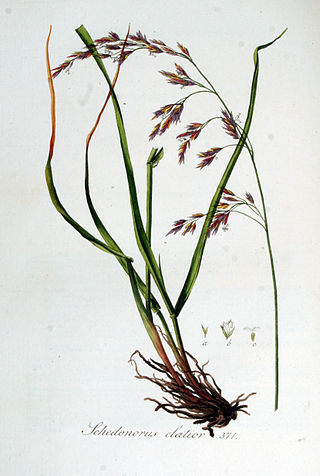
Lolium arundinaceum, tall fescue is a cool-season perennial C3 species of grass that is native to Europe and California. It occurs on woodland margins, in grassland and in coastal marshes. It is also an important forage grass with many cultivars that used in agriculture and is used as an ornamental grass in gardens, and sometimes as a phytoremediation plant.

Lolium multiflorum is a ryegrass native to temperate Europe, though its precise native range is unknown.
Agropyropsis is a monotypic genus of grasses closely related to Catapodium. It is native to the Batna Province in northeastern Algeria, and only contains a single species, Agropyropsis lolium. It once included a second species, Agropyropsis gracilis, which has since been renamed and moved to Lolium canariense.
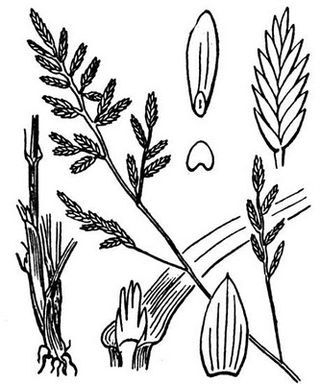
Catapodium is a genus of Eurasian and North African plants in the grass family.

Argyrolobium is a genus of flowering plants in the family Fabaceae. It belongs to the subfamily Faboideae. Members of this genus are found in Africa, western and south Asia, and southern Europe.
Lolium tuberosum is a species of flowering plant in the family Poaceae, native to Spain and Morocco. It was first described in 1983 as Micropyropsis tuberosa. When placed in the genus Micropyropsis, it was the only species. Under its synonym, the species is listed as endangered.
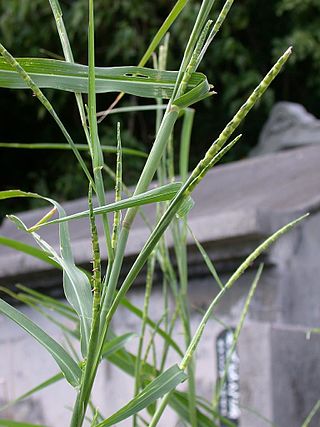
Rottboellia is a genus of African, Asian, and Australian plants in the grass family.

Rytidosperma is a genus of plants in the grass family. Most of the species occur in Australasia, with a few in insular Southeast Asia, southern South America, and certain islands of the Pacific. Several are known by the general common name wallaby grass.
British NVC community OV23 is one of the open habitat communities in the British National Vegetation Classification system. It is one of six communities characteristic of gateways, tracksides and courtyards.
The Bismarck cicadabird is a species of bird in the family Campephagidae. It is endemic to islands in the Bismarck Archipelago. It was previously considered to be conspecific with the common cicadabird.

Lolium giganteum, giant fescue, is a woodland grass that grows on neutral to base-rich soils, often near streams or other damp places. It is native to Europe and much of Asia and has been introduced to parts of North America.
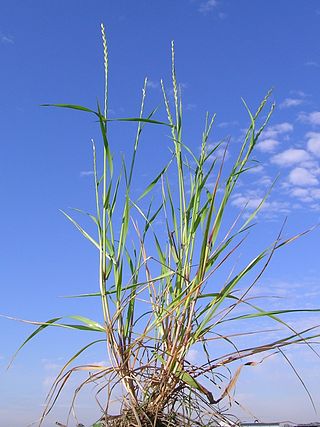
Lolium rigidum is a species of annual grass. Common names by which it is known include annual ryegrass, a name also given to Italian ryegrass, rigid ryegrass, stiff darnel, Swiss ryegrass and Wimmera ryegrass. It is a native of southern Europe, northern Africa, the Middle East and the Indian subcontinent and is grown as a forage crop, particularly in Australia, where it is also a serious and economically damaging crop weed.
Leucadendron remotum, the Nieuwoudtville conebush, is a flowering shrub that belongs to the genus Leucadendron and forms part of the fynbos biome. The plant is endemic to the Northern Cape where it occurs on the Bokkeveld escarpment south of Nieuwoudtville.














